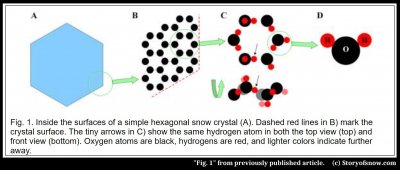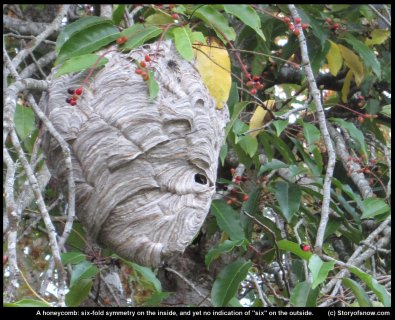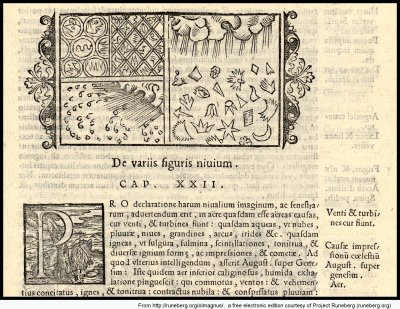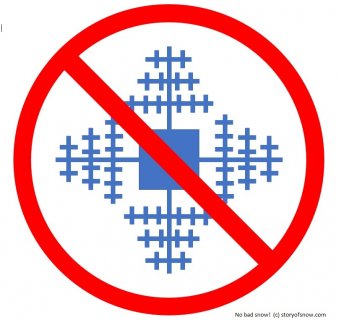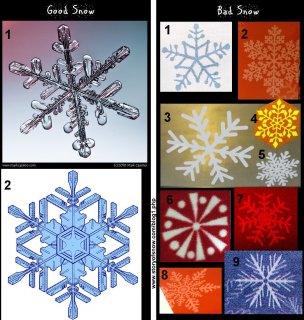Category: "Snow in popular culture"
Why six?
March 2nd, 2022[This is the sixth in the series of re-posted articles, from 2011.]
Why do so many snow crystals look about the same when rotated by 1/6 of a turn? What’s the origin of the six-fold symmetry? Why not five or seven, as Kepler asked(1)?
Since it always happens, when it begins to snow, that the first particles of snow adopt the shape of small, six-cornered stars, there must be a particular cause; for if it happened by chance, why would they always fall with six corners, and not with five, or seven, as long as they are still scattered and distinct, and before they are driven into a confused mass?
Though we can now answer the last two questions, the first, as pondered by Bentley and many others, still awaits a complete answer.
The thing that allows (but does NOT cause) the crystal to have six-fold symmetry comes down to in its internal crystalline lattice of water molecules. Specifically, if you could zoom in about a million times into any region of a snow crystal, such as the corner in figure 1A below, you would see a lattice of hexagonal rings B) – like a microscopic internal honeycomb. The oxygen atoms (black) in each ring have the six-fold symmetry. But if you further examine the rings, notice that all of them are rotated by 30º in relation to the crystal hexagon in A).
However, if you look even closer, such that you can see the orientations of the molecules, and turn the ring on its side, as in C), you will see that in fact the ring is not perfectly six-fold symmetric and it’s not even flat! The honeycomb inside ice is not so simple. But if you sought the overly simplified answer to the origin of the “6”, find it in the hexagonal lattice. Call that the answer for the easily persuaded. There are serious problems though with that answer.
The simple answer specifically has two problems. The internal honeycomb just gives us a similarity between the ice lattice and the crystal form – it suggests that the crystal may develop six-fold symmetry. But just because a crystal may have six sides doesn’t mean it will have six sides. Or, to use one of Kepler’s examples, a beehive also has an internal honeycomb structure, and yet from the outside it appears blobby and nondescript – hardly six-sided.
Bad Snow, Part II, and Some History
December 11th, 2017The recent post about bad snow (see new emblem at bottom) reminded me of an old image that often pops up in historical descriptions about snow. The date was 1555 and Olaus Magnus, an archbishop in Sweden, just published "Description of the Northern Peoples", a long multi-chapter, multi-volume text with the interesting chapter for us being titled "The Shapes of Snow" with the following illustration.
I am not sure what the sections on the left half represent, but the right half shows a fanciful variety of "snow shapes", including a bell, a hand, an arrow, a crescent moon, and one at least in the form of a six-pointed star. Perhaps the author gave incomplete instructions to his illustrator.
At any rate, scholars have suggested that this illustration is actually the first to show the form of snow. Though the Chinese had many centuries before correctly described snow's "six-fold" nature, no illustration has yet been unearthed before Olaus Magnus's above. Luckily, it wasn't so many centuries later that we got much more accurate illustrations from the likes of Descartes and Hooke.
Finally, as promised, the proposed "No bad snow" emblem.
--JN
Bad Snow
November 28th, 2017This post is about the misrepresenting of snow crystals in public, not about misbehaving crystals and not about snow that has gotten dirty.
No doubt you've seen it, the Christmas card with four-pointed "snow" falling, or the sweater with an eight-pointed "snow" emblem. Once, at a holiday party, I saw such a sweater and remarked on it to the wearer. I was told that, with snow, "no two are alike", and apparently that was supposed to justify anything goes. Sorry, but it doesn't work that way. After all, we can say the same thing about people, that is, no two of us are exactly alike, and yet we do not regularly see sketches of people with five arms or three heads. That is because people do not come in these shapes. Similarly, snow-crystal growth allows unlimited crystal forms, but nevertheless follows strict rules. If you understand these rules, you too can point out impossible snow-crystal shapes. I give the rules below.
But to help illustrate these rules, I first present below examples of real and "good" snow, together with some examples of bad snow:
Click on this (and any image here) to see a larger version.
